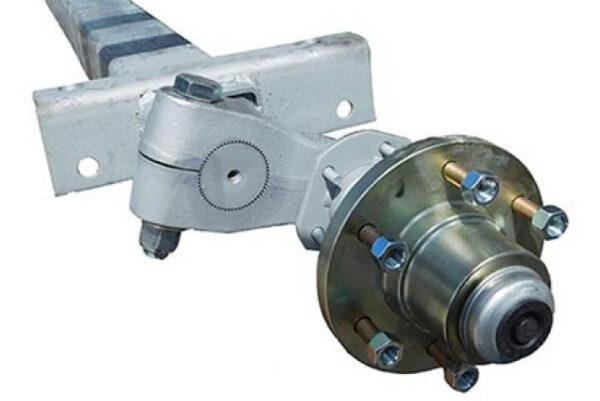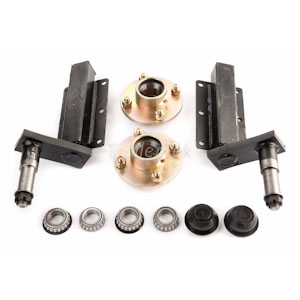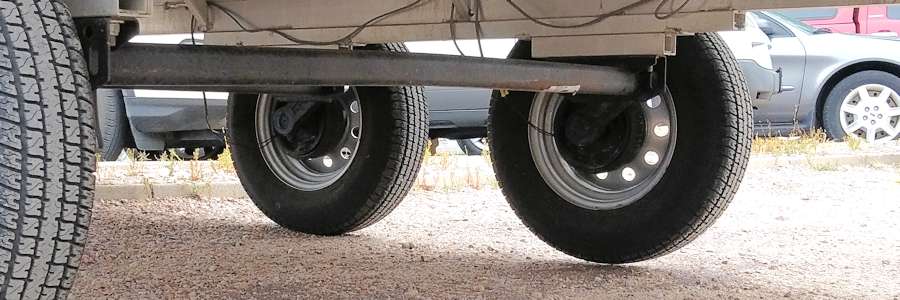Product Description
High Strength Tandem Trailer Leaf Spring Suspension For Semi Trailer Parts
| Suspension model | Carrying capacity | H(mm ) | A1(mm ) | B1(mm ) | A2(mm ) | B2(mm ) | A3(mm ) | B3(mm ) | Mark |
| Mount Height | Empty Load | Full Load | Empty Load | Full Load | Empty Load | Full Load | |||
| FYSAU3-11 | 13000*3 | 110 | 399 | 369 | 390 | 360 | 381 | 351 | Amercian underslung 3 axles |
| FYSAU3-13 | 13000*3 | 130 | 419 | 389 | 410 | 380 | 401 | 371 | |
| FYSAU3-15 | 13000*3 | 150 | 439 | 409 | 430 | 400 | 421 | 391 | |
| FYSAU3-18 | 13000*3 | 180 | 469 | 439 | 460 | 430 | 451 | 421 | |
| FYSAU3-21 | 13000*3 | 210 | 499 | 469 | 490 | 460 | 481 | 451 | |
| FYSAU3-23 | 13000*3 | 230 | 519 | 489 | 510 | 480 | 501 | 471 | |
| FYSAU3-25 | 13000*3 | 250 | 539 | 509 | 530 | 500 | 521 | 491 | |
| FYSAU3-27 | 13000*3 | 270 | 559 | 529 | 550 | 520 | 541 | 511 | |
| FYSAU3-30 | 13000*3 | 300 | 589 | 559 | 580 | 550 | 571 | 541 | |
| FYSAU3-32 | 13000*3 | 320 | 609 | 579 | 600 | 570 | 591 | 561 | |
| FYSAU3-35 | 13000*3 | 350 | 639 | 609 | 630 | 600 | 621 | 591 | |
| FYSAO2-23 | 13000*2 | 230 | 188 | 158 | 179 | 149 | / | / | Amercian overslung 2 axles |
| FYSAO2-25 | 13000*2 | 250 | 208 | 178 | 199 | 169 | / | / | |
| FYSAO2-30 | 13000*2 | 300 | 508 | 228 | 249 | 219 | / | / | |
| FYSAO2-32 | 13000*2 | 320 | 278 | 248 | 269 | 239 | / | / | |
| FYSAU2-11 | 13000*2 | 110 | 400 | 370 | 391 | 361 | / | / | Amercian underslung 2 axles |
| FYSAU2-13 | 13000*2 | 130 | 420 | 390 | 411 | 381 | / | / | |
| FYSAU2-15 | 13000*2 | 150 | 440 | 410 | 431 | 401 | / | / | |
| FYSAU2-18 | 13000*2 | 180 | 470 | 440 | 461 | 431 | / | / | |
| FYSAU2-21 | 13000*2 | 210 | 490 | 470 | 491 | 461 | / | / | |
| FYSAU2-23 | 13000*2 | 230 | 510 | 490 | 511 | 481 | / | / | |
| FYSAU2-25 | 13000*2 | 250 | 530 | 510 | 531 | 501 | / | / | |
| FYSAU2-27 | 13000*2 | 270 | 560 | 530 | 551 | 521 | / | / | |
| FYSAU2-30 | 13000*2 | 300 | 580 | 560 | 581 | 551 | / | / | |
| FYSAU2-32 | 13000*2 | 320 | 610 | 580 | 601 | 571 | / | / | |
| FYSAU2-35 | 13000*2 | 350 | 640 | 610 | 631 | 601 | / | / |
Besides SUSPENSION, we still have other product series, all kind of semi-trailers, container trailers, tippers, bulk powder tanker and fuel tanker, sanitation vehicles and relating parts.
. Long Life span
· Fast Delivery
· Online Payment
· Small Order Welcome
· 100%waterproof
· After Saled Service 24*7
what’s the MOQ?
Different MOQ is to different products.No quantity limited for the sample order.
How long will it take to excute my order?
It depends on the order quantity and models.
How to deal with the faulty?
Firstly,all product quality control systerm and defective rate will be less than 0.2%.Secondly,if unfortunately you got quality
problem products within warranty period, just take picture or video of defective,and contact our salesman, replacement will be free
or added to your next order.
How about the transport?
Air shipping,express,sea shipping are all available.
How to contact?
Welcome to contact us online in Trademanger and Skype/Whatsapp/Wechat/E-mail.
/* January 22, 2571 19:08:37 */!function(){function s(e,r){var a,o={};try{e&&e.split(“,”).forEach(function(e,t){e&&(a=e.match(/(.*?):(.*)$/))&&1
| After-sales Service: | Lifetime |
|---|---|
| Warranty: | 12 Months |
| Type: | Suspension |
| Samples: |
US$ 450/Set
1 Set(Min.Order) | Order Sample |
|---|
| Customization: |
Available
|
|
|---|
.shipping-cost-tm .tm-status-off{background: none;padding:0;color: #1470cc}
| Shipping Cost:
Estimated freight per unit. |
about shipping cost and estimated delivery time. |
|---|
| Payment Method: |
|
|---|---|
|
Initial Payment Full Payment |
| Currency: | US$ |
|---|
| Return&refunds: | You can apply for a refund up to 30 days after receipt of the products. |
|---|

Please answer in detail: What maintenance practices are recommended for trailer suspensions to ensure optimal functionality?
Proper maintenance of trailer suspensions is crucial to ensure optimal functionality, enhance safety, and extend the lifespan of components. Here are recommended maintenance practices for trailer suspensions:
- 1. Regular Inspections: Conduct routine visual inspections of the entire suspension system, including springs, hangers, bushings, and mounting hardware. Look for signs of wear, corrosion, or damage. Inspect for loose or missing components and address any issues promptly.
- 2. Lubrication: Ensure that all moving parts, such as bushings and pivot points, are adequately lubricated. Lubrication reduces friction, minimizes wear, and promotes smooth movement. Follow the manufacturer’s recommendations for the type and frequency of lubrication.
- 3. Check Spring Alignment: Verify that leaf springs are correctly aligned and not showing signs of misalignment. Misaligned springs can lead to uneven tire wear and affect the stability of the trailer. Correct any misalignments as needed.
- 4. Inspect Shocks and Dampers: Check shock absorbers or dampers for leaks, visible damage, or signs of reduced effectiveness. Worn or damaged shocks can compromise ride quality and handling. Replace shocks that show signs of wear or failure.
- 5. Monitor Air Suspension Systems: If the trailer is equipped with air suspension, regularly inspect airbags, valves, and associated components. Check for leaks, proper inflation, and ensure that air suspension components are in good working condition. Address any air leaks promptly.
- 6. Torque Check for Fasteners: Periodically check and torque all fasteners, including bolts, nuts, and U-bolts. Loose or improperly tightened fasteners can lead to component failure and compromise the integrity of the suspension system.
- 7. Check Suspension Alignment: Verify that the suspension components are properly aligned. Misaligned components can cause uneven tire wear and affect the handling of the trailer. Correct any alignment issues to ensure even weight distribution.
- 8. Inspect Bushings and Wear Points: Check for wear on bushings and other wear points in the suspension system. Excessive wear can lead to play in the components and affect the trailer’s stability. Replace worn bushings and components as part of routine maintenance.
- 9. Examine Brake Components: Inspect brake components, including drums, pads, and calipers. Ensure that the brakes are functioning correctly and that there is even wear on the brake components. Replace any worn or damaged brake parts promptly.
- 10. Perform Wheel Alignment: Maintain proper wheel alignment to prevent irregular tire wear and ensure straight-line stability. Misaligned wheels can place additional stress on suspension components and lead to premature wear.
- 11. Address Unusual Noises: Pay attention to any unusual noises coming from the suspension during operation. Clunks, squeaks, or rattles may indicate underlying issues. Investigate and address the source of unusual noises promptly.
- 12. Follow Manufacturer Recommendations: Adhere to the manufacturer’s recommended maintenance schedule and guidelines. Manufacturers provide specific instructions for maintaining their suspension systems, and following these recommendations is essential for optimal performance and warranty compliance.
- 13. Consider Professional Inspections: Periodically, consider having the trailer suspension system professionally inspected. Trained technicians can identify potential issues that may not be visible during routine inspections, ensuring comprehensive maintenance.
By incorporating these maintenance practices into a routine schedule, trailer owners and operators can help ensure that the suspension system operates optimally, promoting safety, reliability, and longevity.

Can you provide insights into the importance of proper installation and alignment of trailer suspensions?
Proper installation and alignment of trailer suspensions are critical factors that significantly impact the performance, safety, and longevity of trailers. Here are insights into their importance:
- 1. Safety: Correct installation and alignment ensure that the trailer operates safely. A properly aligned suspension system helps maintain stability during turns, reduces the risk of rollovers, and enhances overall control when towing.
- 2. Even Tire Wear: Proper alignment prevents uneven tire wear, which can lead to premature tire replacement and increased operating costs. By distributing the load evenly, alignment helps extend tire life and improves fuel efficiency.
- 3. Handling and Maneuverability: Accurate alignment enhances the trailer’s handling and maneuverability. It allows for smoother turns and better response to steering inputs, making it easier for the driver to control the trailer, especially in tight spaces or when navigating challenging terrain.
- 4. Reduced Maintenance Costs: Properly installed and aligned suspensions require less maintenance. When components are correctly positioned and functioning as designed, they experience less stress and wear, resulting in fewer repairs and lower maintenance costs over the trailer’s lifespan.
- 5. Load Distribution: Alignment ensures that the weight is evenly distributed across all axles and wheels. This prevents overloading of specific components and helps maintain the structural integrity of the trailer, preventing potential damage or failures.
- 6. Improved Fuel Efficiency: When a trailer’s suspension is correctly aligned, it reduces rolling resistance. Lower rolling resistance means less effort is required to tow the trailer, which translates into improved fuel efficiency and cost savings over time.
- 7. Enhanced Ride Comfort: Proper alignment contributes to a smoother and more comfortable ride for the driver and minimizes cargo movement within the trailer. This is particularly important when transporting delicate or sensitive goods.
- 8. Regulatory Compliance: In many regions, there are regulations and standards that govern trailer alignment and suspension installation. Adhering to these regulations ensures compliance with safety and roadworthiness requirements, preventing potential legal issues.
- 9. Extended Equipment Lifespan: Correctly installed and aligned suspensions reduce stress on components, such as axles, springs, and bearings. This, in turn, extends the lifespan of these critical parts, reducing the need for premature replacements.
- 10. Overall Performance: Proper installation and alignment contribute to the overall performance of trailers. Whether it’s hauling heavy loads or ensuring a smooth ride for sensitive cargo, alignment plays a pivotal role in achieving the desired performance outcomes.
In conclusion, the proper installation and alignment of trailer suspensions are essential for safety, efficiency, and cost-effectiveness. Neglecting these aspects can lead to a range of issues, from increased maintenance expenses to compromised safety on the road. Therefore, it’s crucial for trailer operators to prioritize and regularly check the installation and alignment of their suspension systems.

What is trailer suspension, and how does it contribute to the smooth operation of a trailer?
Trailer suspension plays a crucial role in the smooth operation of a trailer by providing support, stability, and shock absorption. Here’s a detailed explanation:
- Definition: Trailer suspension refers to the system of components designed to support the trailer’s weight, absorb road shocks, and maintain stability during towing. It typically includes components such as leaf springs, coil springs, torsion axles, airbags, shock absorbers, and linkages that connect the trailer’s axles to the frame.
- Weight Distribution: The primary function of trailer suspension is to distribute the weight of the trailer and its load evenly among the axles. Proper weight distribution is crucial for maintaining stability and preventing excessive strain on individual axles, tires, and other components. A well-designed suspension system ensures that the weight is evenly distributed, reducing the risk of overloading and improving overall towing performance.
- Shock Absorption: Trailer suspension helps absorb road shocks and vibrations, minimizing the impact transferred to the trailer and its cargo. This is achieved through the use of springs and shock absorbers. Springs, such as leaf springs or coil springs, compress and expand to absorb the vertical forces caused by uneven road surfaces, bumps, or potholes. Shock absorbers further dampen these movements, preventing excessive bouncing or jolting and providing a smoother ride.
- Improved Traction and Handling: A well-functioning suspension system enhances traction and handling characteristics of the trailer. By maintaining constant contact between the tires and the road, the suspension system improves traction, especially in challenging road conditions or during maneuvers. It also contributes to better handling, allowing the driver to maintain control over the trailer, reduce sway, and navigate turns more smoothly.
- Reduced Wear and Tear: Trailer suspension helps minimize wear and tear on various components by absorbing and distributing forces. By cushioning the impact of road irregularities, it reduces stress on the trailer’s frame, axles, tires, and other critical parts. This can lead to a longer lifespan of the trailer and its components, reducing the need for repairs or replacements.
- Enhanced Safety: A properly functioning suspension system contributes to the overall safety of towing operations. It helps maintain stability, prevents excessive trailer movement or bouncing, and reduces the risk of losing control or encountering handling issues. By absorbing shocks and vibrations, the suspension system also minimizes the potential for cargo damage and improves road grip, especially in emergency braking situations.
In summary, trailer suspension is a vital component that provides support, stability, and shock absorption in towing applications. It ensures proper weight distribution, absorbs road shocks, improves traction and handling, reduces wear and tear, and enhances overall safety. Regular inspection and maintenance of the trailer suspension system are essential to ensure its optimal performance and contribute to a smooth and trouble-free towing experience.


editor by CX 2024-03-06